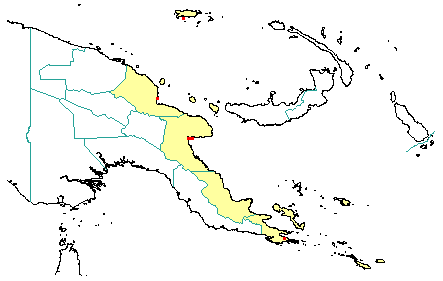
in PNGplants database
PNGTrees – Avicennia alba Blume |
Barry Conn (NSW) & Kipiro Damas (LAE).
Copyright held by the authors, Royal Botanic Gardens and Domain Trust, and Papua New Guinea National Herbarium
Bijdragen tot de flora van Nederlansch Indië Vol. 14: 821 (1826)
Other Literature: N.C. Duke, Australian Systematic Botany Vol. 4: 307-309 (1991) Fig. 5.
Field Characters: Small trees often about 10 m high, frequently a shrub or large trees up to 25 m high. Bole cylindrical; straight; buttresses absent; spines absent; aerial roots rarely present just above base; pneumatophores about 20 cm high, 5-10 mm wide near apex or absent; stilt roots absent. Bark black or dark brown, rough or smooth, pustular warty or often fissured forming short longitudiinal fisures and very small scales; lenticels elongated vertically; subrhytidome pale yellow cream-coloured or green; bark thickness <25 mm thick; blaze consisting of one layer; faintly to non-aromatic; outer blaze pale yellow or white, markings absent, smooth spongy; inner blaze white or pale yellow, markings absent, smooth spongy; exudate absent. Terminal buds not enclosed by leaves; complex hairs absent; stinging hairs absent; mature twig without hairs.
Leaves: Spaced along branches <internodes readily visible>. Leaves opposite, simple; petiole present 4-12(-21) mm long, not winged, attached to base of leaf blade <not peltate>, slightly swollen <at tip, or base, or both> at base; lamina broadest at or near middle or slightly broadest above middle, 7.5-9.0 (-11.0) cm long, 3.0-4.0 (-6.0) cm wide; lamina symmetric, margin entire, not dissected or lobed, apex obtuse, venation pinnate <secondary veins arising from the midrib along its length>, secondary veins open <spaced far apart to easily see tertiary veins>, not prominent, but visible, intramarginal veins absent; lower surface grey silvery green or green, upper surface glossy dark green, hairs often present or absent, sparse minutely hairy on lower leaf surface; oil dots absent; domatia absent; stipules absent.
Flowers: Inflorescence terminal <at branch ends> or axillary <from between a leaf and branch> in distal axils. Flowers on a branched axis flowers in spike-like clusters; flowers bisexual, not stalked aromatic, with many planes of symmetry <actinomorphic>, 3.0-5.0 mm long, small (< or =10 mm diam.) 3-4 mm diam.; perianth present, with distinct sepals and petals, orange or yellow; inner perianth 4 sometimes (-6), some or partly joined lobes 2.5-5 mm long; stamens 4 sometimes (-6), filaments present, free of each other, joined to perianth <epipetalous/episepalous> ovary superior <seated above petals and sepals; hypogenous>, carpels joined (when more than one) <syncarpous>, locules 1; styles absent (by misinterpretation) or solitary <including joined together> minute, barely extended from ovary, 1.
Fruits: Fruits arranged on branched axis. Fruit 21-33 mm long, 8.0-15.0 mm diam., fruit greenish grey dull or pale green, not spiny, non-fleshy, simple, dehiscent, capsule. Seeds 1 (-2) (seedlings developing on plant), not winged, as wide as long.
Distribution: Milne Bay, Morobe, Manus, Northern, Papuan Islands & Madang.
 | Botanical records in PNGplants database |
Notes: The seedling (radicle) of this species is about 9 mm long and is mostly glabrous with a dense hairy collar about 2 mm wide, with hooked hairs.
Previously placed in the Verbenaceae and more recently in its own family, the Avicenniaceae.